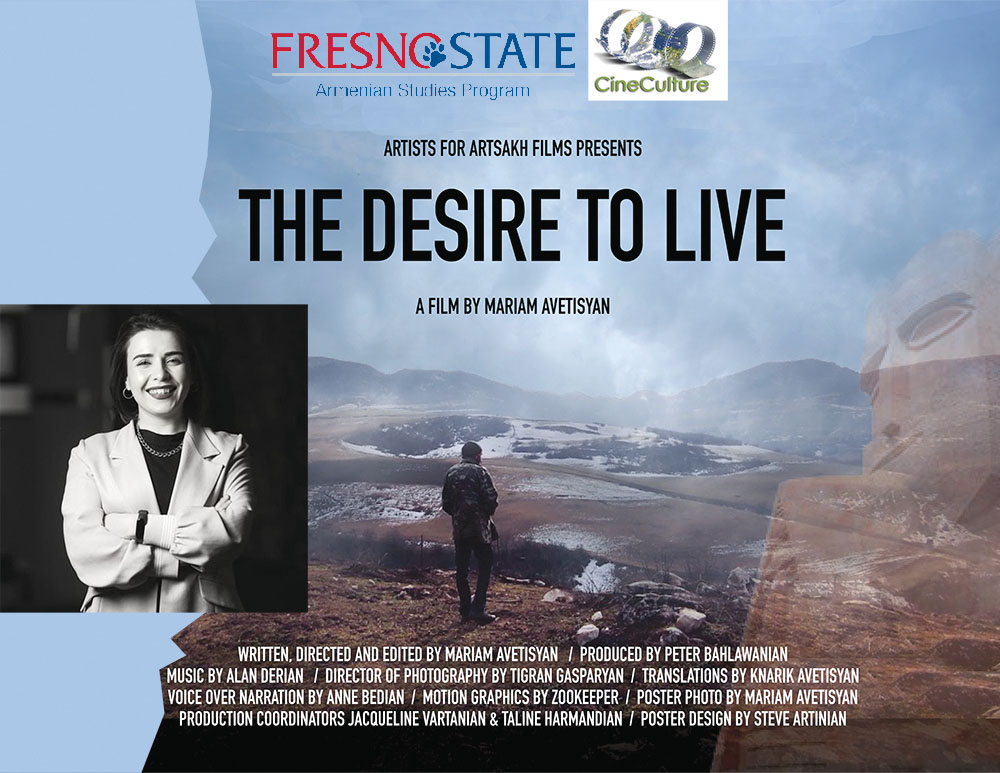 Andrew Hagopian
Andrew Hagopian
Editor
“I was born in Sushi in 2012. I was going to school-the third grade. I used to go to Djzdrduz (Hunot Canyon, Shushi) and pick lillies. Our house in Shushi was the best. I wanted to protect my homeland Shushi.” These are the thoughts and words of a 10-year-old boy expressing his emotions for his homeland in the documentary “The Desire to Live” directed by Mariam Avetisyan.
The Armenian Studies Program and CineCulture at Fresno State organized a virtual discussion with director Mariam Avestiyan and producer Peter Bahlawanian on Friday, April 22, 2022. Students and participants had the opportunity to watch the 90-minute documentary online during the week prior to the discussion. Students filled the chat with a variety of questions for Avetisyan.
“The Desire to Live” is a 110-minute no-commentary style documentary feature film, which focuses on the post-war life of Armenians and the aftermath of the September-November 2020 war against the indigenous Armenian population in Artsakh. Prof. Barlow Der Mugrdechian and CineCulture professor Dr. Mary Husain introduced Avetisyan and Bahlawanian and then opened the floor to questions from the audience.
Avetisyan wants the world to be aware of what is happening to the Armenians of Artsakh. “My message is for peace,” said Avetisyan. “I wanted to portray how the Armenians of Artsakh dream of peace, and want to live normal lives.” Azerbaijan has tried to force the Armenians of Artsakh to leave by periodically cutting off the gas, telephone, and water to make life unlivable.
“For the Armenians of Artsakh, one way to survive is by dreaming of peace and to have hope for the future,” said Avetisyan.
Avetisyan was asked what the hardest part of the documentary to film was. She responded by telling the story of a young boy who had lost his father in the war and who was reminiscing about the memories he shared with his father working in the fields. The boy especially remembered the strong bond between he and his father.
Avetisyan said that many of her interviewees were initially unwilling to open up before the camera, however she was able to engage them in a friendly conversation, thus putting them at ease. “The men who were interviewed admitted to me that they were shocked that they would ever express emotion of sadness or grievance,” stated Avetisyan.
For Avetisyan, filming so many of the sad stories ultimately also took their toll on her. “It began to effect me greatly,” said Avetisyan. “Many times I cried as we were filming. It helped to discuss my interviews with my family.” The story about a woman who had lost two brothers and a son in the conflict was particularly moving. She had kept her son’s cell phone and would send text messages to him. She then would read those messages as a way to remain in contact with him.
“The Desire to Live” began originally as an online documentary series to bring social awareness of the effects of the war on the people of Artsakh and their livelihood. Within two seasons, twenty-five episodes were filmed, and over 100 subjects interviewed throughout the land of Artsakh. Bahlawanian, a movie producer from Los Angeles, personally funded this project to make it a full feature film. Funding included personal financing plus a GoFundMe campaign which covered the costs of premiering the documentary at various film festivals throughout the United States.
Avetisyan would like the world to know of the struggles of the Armenians of Artsakh. There are many non-profits and foundations working in Artsakh today and people can get involved by contributing to those efforts.
The episodes from “The Desire to Live” series can be viewed at this site: https://cftjustice.org/the-desire-to-live.
 Hye Sharzhoom Armenian Action
Hye Sharzhoom Armenian Action